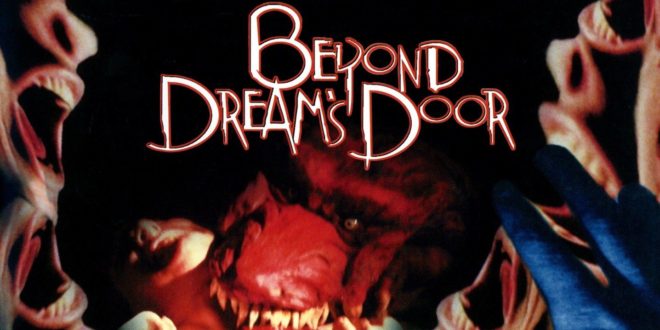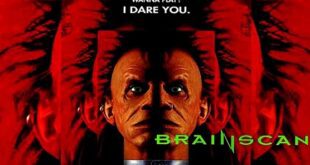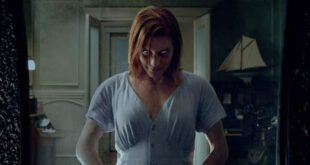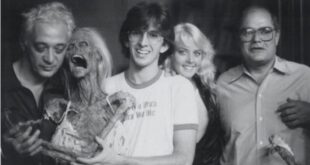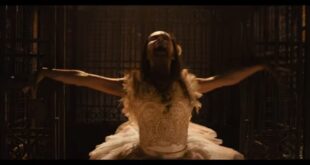The homemade aesthetic of no budget indie horror flicks has long had an appeal to me. They have a different flavor from their more polished and conventionally made brethren. I also love seeing my longtime home of Columbus, Ohio, onscreen since it doesn’t happen very often. I’m sure most American movie fans who don’t live in the traditional film towns of New York, LA, or Chicago can relate. So, when I heard that boutique Blu-ray label Vinegar Syndrome would be releasing Beyond Dream’s Door, a film made by students and alumni from Ohio State University (my alma mater) and shot in Columbus as part of their Homegrown Horrors Collection along with Fatal Exam (1988 – read our review here) and Winterbeast (1992), I knew that it would be an instant purchase.
Writer/Director/Composer Jay Woelfel (Trancers 6 2002) unleashed Beyond Dream’s Door, a lightly Lovecraftian and surrealist tale about college undergrad Ben Dobbs (a slightly too old Nick Baldasare: They Bite 1996) and the torments inflicted on him by nightmares made manifest in 1989. When the intensity of the visions begins to increase, blurring the lines between the waking and dreaming worlds, he seeks help from his mischievous psychology instructor, Professor Noxx (Norm Singer). After reading an account of Ben’s troubles, he, too, starts to experience inexplicable phenomena. Soon, Eric Baxter (Rick Kesler: Ghost Lake 2004) and sweetheart and fellow TA Julie Oxel (Susan Pinsky) are also drawn into the eerie proceedings. Small but notable roles also belong to Daniel White as a mysterious man from the past with connections to the situation, John Dunleavy as gleefully creepy custodian, Darby Vasbinder as a seductive apparition, Lucas Simpson as a strange little boy, and Marge Whitney as Julie’s mom.

Woelfel’s script for Beyond Dream’s Door is more focused on creating a disorienting atmosphere than character development or straightforward coherence. Often, we follow characters through dreams within dreams within dreams so that their confusion about what is real is interwoven with our own. Dialogue is mostly naturalistic, although we get a few moments of awkward exposition along with some disembodied voiceover of portentously dark poetry. Beyond Dream’s Door purposefully eschews realism for a sort of dream logic. It’s never opaque, though, and if you give yourself over to that approach, I think you’ll find it’s relatively easy to follow despite the unconventional structure. Story elements don’t necessarily snugly fit together, but it absolutely works given the subject matter. Considering this was originally based on a 20-minute film school short, it’s a fairly impressive feat Beyond Dream’s Door never feels padded or disjointed.
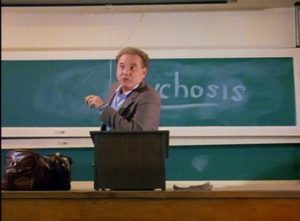
Most of the primary performers for Beyond Dream’s Door were recruited from Woelfel’s circle of friends and Columbus’ local theater scene. While that might mean we’re not treated to Hollywood caliber acting, I wouldn’t say anybody is wooden or amateurish. I was actually surprised by how much the actors were able to draw me in to a fairly bizarre world. Baldasare holds our attention and is relatable as a troubled boy-next-door type. Kesler has the second largest role, and he is believable as the initially incredulous grad student. Pinsky has natural screen presence, so it surprised me that she pursued medicine and never acted again. Singer is fun in limited screen time.
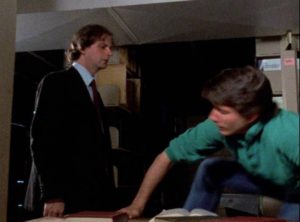
Scott Spears (Asylum of Darkness 2017 – read our review here) shot Beyond Dream’s Door. He peppers the film with close-ups and a few nicely orchestrated tracking and dolly shots, ensuring that the imagery isn’t static or boring. Lighting is exaggerated here and there to assist in the otherworldly dread department, making for some unsettling compositions. Though the narrative is meant to be off-kilter, his storytelling is clear and assured. My favorite sequence is a stylish chase through a sewer system.
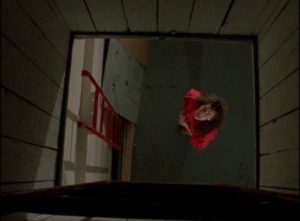
Speaking of locations, those familiar with Columbus will surely recognize scenes shot in OSU’s massive main library and a handful of other campus buildings, off campus student housing immediately to the north of OSU, and the quarry located near the San Margherita neighborhood. The quarry scenes with their ruined housing structures and dream ghouls are certainly cool, but the most visually interesting spot is the one that kicks off the aforementioned sewer sequence. Glen Echo Ravine’s notorious Gates of Hell with its angular girders, copious graffiti, and dank subterranean entrance makes for a grand cinematic visual.
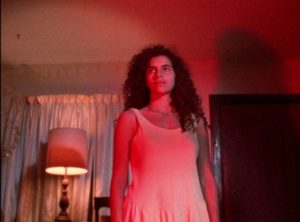
Susan Resatka (Road Meat 1989) and porn actor Randy Spears’ editing subtly assist with the dreamy tone in Beyond Dream’s Door. There are numerous smash cuts and dissolves that keep us uncertain about what we’re seeing. Though this is far from a splatter film with horror being mined in a more psychological manner, there are a few grisly effects. My favorite gags involve Professor Noxx’s gooey fate and the skewering of a hand. The monster isn’t particularly convincing, but the filmmakers do their best to tease and conceal the beast without being too obvious or frustrating. Woelfel’s instrumental score is admirably creepy and melancholy.
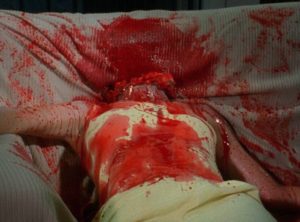
Beyond Dream’s Door was made for a mere $60,000, and I think it’s absurd to nitpick a production of that nature, especially since it pretty much accomplishes everything it sets out to do. It’s not a perfect film, though. I would say that Eric’s response to what befalls Julie is a bit of a head-scratcher. Additionally, the moments where the film wants to explain more concretely what is happening undermine the pleasingly ambiguous tone. It’s to Woelfel’s credit that the T and A requested by the film’s financiers is fairly artfully inserted, but it still feels a little out of place.
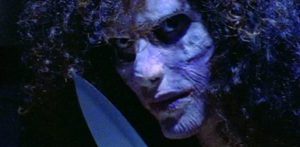
Ultimately, Jay Woelfel’s Beyond Dream’s Door is everything I hoped it would be. At 80 minutes, it crams in some neat gags, cool imagery, and palpable atmosphere while mostly maintaining momentum. I loved seeing locations I recognized in the context of a dreamy horror flick. Vinegar Syndrome’s Blu-ray features a bevy of excellent features, including two retrospectives and a collection of contemporary local news coverage. If you’re like me and enjoy rough around the edges films from off the beaten path, you may find a lot to enjoy here. Recommended for fans of Phantasm (1979 – read our retro review here), Suspiria (1977 – read our retro review here), and Lost Highway (1997).
 PopHorror Let's Get Scared
PopHorror Let's Get Scared
